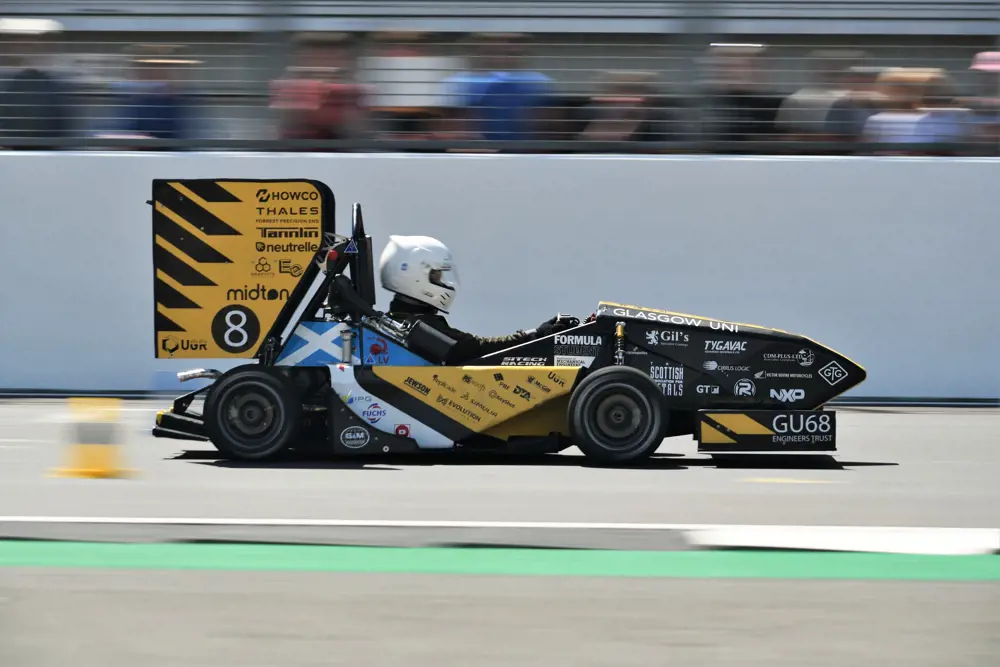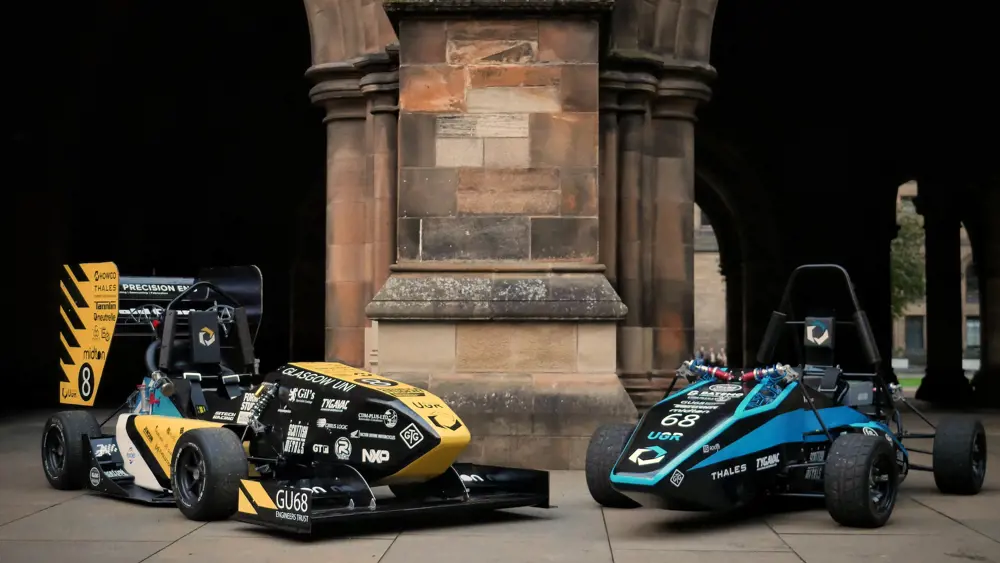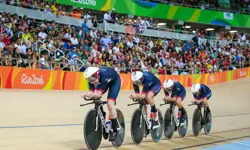
Winning Formula Student
Every year, the Formula Student competition draws in university student teams from across the globe. All are vying to win at the Silverstone track with the single-seat racing cars they have spent months building. Entry vehicles compete in static events, looking at things like chassis design, business plan and dynamic events, including acceleration and braking abilities. Electric and driverless vehicles are also playing an increasingly large role in the competition, which tests the teams’ engineering, software development, manufacturing, business planning, and driving abilities.
After an immense year of hard work and dedication, the UGRacing team was hugely proud and honoured to take the overall win at Formula Student UK 2022. The competition also saw its driverless team build on its impressive debut competition in 2021. After a challenging start, the team overcame some unexpected hardware issues to complete the acceleration event and gain our first dynamic points at the competition – achieving 8th position overall!

© UGRacing, University of Glasgow
Last in its line: UGR-IC22
UGR-IC22 is our fastest Formula Student internal combustion entry so far. (It will also be our last, as we shift focus to electric vehicles from the next competition onwards.) After successes in the dynamic categories with our 2021 entry, the team worked to refine the whole package, increasing peak power, and improving the overall fit and finish of the car.
One of the biggest areas of development this year was in the aerodynamics package. This year, our simple but solid assembly proved itself to be faultless throughout the competition. In the process, the UGRacing team also learned a huge amount about composite material manufacturing.
With our powertrain assembly, our aim was to create a smooth power delivery, tailored to the Formula Student tracks. This would help get young amateur drivers up to speed in the car quickly, as a result improving our dynamic event pace. Always looking for cheaper, more time-efficient and more renewable ways of developing our aerodynamics package, recyclable elements and an increased use of glass fibre-reinforced polymer reduced the overall cost hugely from our 2021 entry. The team built on last year’s ‘Fishy Filament’ 3D printed endpieces with vacuum-formed wing skins to reduce the amount of carbon in the upper, non-structural elements. This was incredibly successful and thanks to the removable internal tube structure, the upper elements can be fully recycled. We also used Ceconite aircraft fabric for the main bodywork for the first time, which created our cleanest, lightest bodywork assembly to date.
The road to Silverstone
For the combustion team, the journey to this year’s competition was a testing one. We experienced countless delays in orders and parts, under-spec components, failed composite layups and welder breakdowns all holding back the manufacture for weeks at a time. As a result, the manufacturing team had to work day and night to produce a running driving car for the early June launch date so that driver training and testing could take place between then and the competition in July.
From there followed weeks of testing and setup. With improved testing plans and driver training at Kames Motorsport Complex in East Ayrshire, the team ironed out all the small issues and dialled in a strong dynamic setup for each event, putting us in a strong place ahead of the trip to Silverstone.

Launch day: the internal combustion model (left) and driverless model (right) © UGRacing, University of Glasgow
From the beginning of the year, the driverless team took countless trips to Edinburgh to test with the IMechE’s ADS-DDT vehicle, which is supplied ‘autonomous system ready’ so that teams can select their own controller and sensors, uploading their own bespoke software into the vehicle. The experience working with the car and being able to rectify all the small issues before arriving at the competition built up the team’s confidence ahead of the competition.
Scrutineering
Following feedback from the 2021 competition, the team spent a lot of time preparing the 2022 entry for scrutineering, where competing vehicles are checked to see if they comply with the competition regulations.
To prepare, the team undertook multiple rules checks and addressed potential issues. The team had a successful first day, until a small discrepancy was noted with the shoulder harness bar.
Annoyed with such an easily avoidable mistake, the team worked hard over the next 36 hours to rectify it, pass scrutineering and get the car ready for the event on Saturday morning. Having made it with 30 minutes to go until the end of the acceleration and skid pad events – which if we hadn’t passed on time, we could have missed out on points – the team achieved solid runs in both and placed well, allowing some breathing space before the sprint event later in the afternoon.
Results, and an electric future
Across four days of sunshine and tough competition, we placed first overall in the dynamic events category, with first, second, third and fourth in the sprint, skid pad, endurance and acceleration events respectively. A strong performance in the static events saw the team reach the final for the second straight year in the design event, coupled with an eighth-place finish in the cost and manufacturing event – a personal best in recent years. All told, UGRacing scored a total of 792.9 points, giving the team the overall win by just over 100 points and securing our place as one of the top teams in Formula Student UK history.
As a final farewell to the Glasgow team’s combustion era, the team cannot thank all our sponsors, university staff and team members, past and present enough, who made this incredible opportunity possible. The team now has its full focus on our 2023 electric vehicle entry. We will also be furthering our driverless development, where we will be looking to design and manufacture the team’s first actuation systems, working towards our long-term goal of a fully driverless vehicle.
Contributors
Jamie Clarke
Team Principal, UGRacing, University of Glasgow
Keep up-to-date with Ingenia for free
SubscribeRelated content
Sports & leisure

How technology enhances the Wimbledon tennis experience
The All England Lawn Tennis and Croquet Club (AELTC) and IBM worked closely together since 1990 to harness innovative technology to transform The Championships into one of the most popular and technically advanced events on the international sports calendar.

Noise-cancelling headphones
Used by plane and train passengers wanting to listen to radio, music or film without hearing background noises, active noise-cancelling (ANC) headphones are able to prevent outside noise from leaking through to the inside of headphones.

How to create the perfect wave
From small waves lapping at your feet and swells suitable for surfing to storm waves for testing structures and even tsunamis, waves of any shape and any size can now be engineered. What are the techniques and conditions needed to model waves and what makes some more powerful than others?

Going for gold
The success of Great Britain’s cycling team at the 2016 Rio Summer Olympic Games was celebrated, but what about the closely guarded technology that contributed to their success? The engineering approaches taken to shave as much time as possible off the clock are spoken about by Professor Tony Purnell.
Other content from Ingenia
Quick read

- Environment & sustainability
- Opinion
A young engineer’s perspective on the good, the bad and the ugly of COP27

- Environment & sustainability
- Issue 95
How do we pay for net zero technologies?
Quick read

- Transport
- Mechanical
- How I got here
Electrifying trains and STEMAZING outreach

- Civil & structural
- Environment & sustainability
- Issue 95